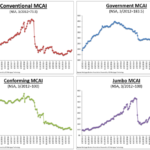Our economy faces many challenges – persistent high mortgage interest rates, a declining rate of existing home sales, elevated costs for basic goods and services, labor market imbalances, and rising health care costs to name just a few. As a new Administration takes over, dozens of policy prescriptions are being discussed that aim to unshackle the greatest economy in the world. But there’s one thing that politicians and business leaders of all stripes and shapes can agree upon – community lenders are the backbone of our nation’s economy.
The three of us – former members of Congress who served on the House Financial Services Committee and now serve as board members for a Federal Home Loan Bank (FHLBank) – have seen how the access to credit that community lenders provide to individuals and local businesses, fosters economic growth, supports job creation, drives stability, and strengthens the broader economy.
The availability of funding at the local level is the driving force in building stronger communities. Mortgage lending, small business loans, and investments in local development projects are all driven by local lenders who know their markets, live in their communities, and have a vested interest in the growth of their economies. What’s more, the health of community lending relies heavily on a robust and enduring FHLBank System, which provides members – especially smaller institutions – with efficient and certain access to the capital markets.
As key partners for their financial institution members across the country, the FHLBanks stand as a foundational source of liquidity for the financial system, powering economic growth, market stability, and housing affordability. As board members for three of the 11 FHLBanks, we have witnessed firsthand the critical role these institutions play in strengthening local communities and in providing stability to the broader financial system.
At their core, the FHLBanks exist to serve their members – community banks, credit unions, insurance companies, and community development financial institutions – by providing access to low-cost, reliable funding. This helps ensure the free flow of affordable mortgages and credit, enabling families to realize the dream of homeownership and providing businesses access to necessary capital for growth.
The FHLBanks are also key players in affordable housing and community development initiatives. Over the past 30 years they have contributed more than $8 billion in affordable housing grants and in 2024 alone contributed an estimated $1 billion in funding for affordable housing and community development.
The FHLBanks’ impact on the financial system cannot be overstated. With 11 regional banks serving different parts of the United States, their ability to inject stability into the financial system, especially during times of economic uncertainty, makes them an indispensable part of our financial ecosystem.
But, in the past few years, a growing regulatory overreach has cast a shadow over the FHLBanks’ ability to do their job effectively. Calls for the Federal Housing Finance Agency, regulator of the FHLBanks, to use its authority to reimagine and reconfigure the System to meet ever-changing policy objectives, reflect political expediency rather than economic common sense. Similarly, those who argue the FHLBanks do not do enough to help address housing supply and affordability issues simply do not appreciate or understand the significant impact of the FHLBanks’ core liquidity mission, which promotes broad economic stability and drives housing, community development and job growth at the local level.
Instead, we encourage policymakers and regulators to recognize and reaffirm the fundamental purpose of the FHLBanks, as established by Congress when it created the FHLBank System in 1932, which is to provide liquidity to members and support housing and community economic development.
In today’s environment, where affordable housing is scarce and economic inequality continues to rise, the role of the FHLBanks is more critical than ever. A key element for addressing these issues is greater access to credit for consumers and businesses, which is dependent on access to inexpensive liquidity for financial institutions. Thus, active engagement from policymakers who understand the unique nature of the FHLBanks and the essential role they play in the financial system, is vital to ensuring they remain well-positioned to continue fulfilling their mission. They can only continue to do so if they are allowed to operate with the flexibility and efficiency they have traditionally enjoyed.
As former members of Congress, we understand the need for effective oversight of the financial sector. However, we also recognize that FHLBanks have a proven track record of providing reliable access to liquidity for their members and their role in maintaining stability during financial crises has been crucial. To sustain and enhance their impact, we must advocate for a transparent regulatory framework that prioritizes their cooperative structure, fosters collaboration with policymakers, and ensures that FHLBanks are positioned to meet the needs of the financial system for years to come.
Former U.S. Reps. Lynn Jenkins, Carolyn Maloney, and Steve Stivers now serve on the boards of FHLBank Topeka, FHLBank New York, and FHLBank Cincinnati, respectively.
This column does not necessarily reflect the opinion of HousingWire’s editorial department and its owners.
To contact the editor responsible for this piece: sarah@hwmedia.com





